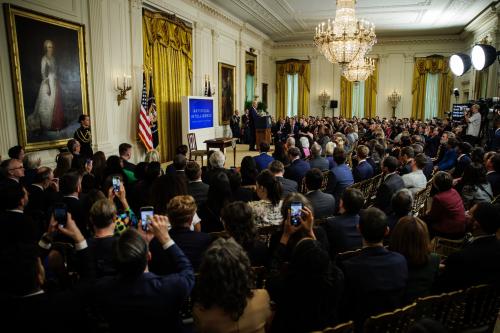Reinventing government was all the rage in the 1990s. It also served as a door-opener for many advocates of front line innovation. This was reflected in Harvard University’s Kennedy School Innovations in American Government Awards program (often called the HKS Award). In the early 1990s, University of Toronto Professor Sandy Borins examined more than 200 applications of semi-finalists for the HKS Award. He sought to discern how government agencies have found ways to introduce innovations in the face of the traditional obstacles facing government innovators: the risk of failure, and the necessity of devoting extra time, energy, persuasion, and improvisation required to bring an innovation to fruition.
Dr. Borins revisited the HKS Awards program in 2010, examining all 238 applications submitted, and compared them to what government innovators had been doing 20 years earlier. In a recent report for the IBM Center for The Business of Government, he found several major differences and some similarities. I’ll highlight two of the differences and one area of continuity.
Increased Collaboration
Successful innovators in government more than doubled their use of collaboration with others over the past two decades. According to Borins: “In the early 1990s, innovation usually meant internal organizational improvement, often by importing private-sector practices (customer service enhancement, total quality management). Many public sector organizations, having made considerable progress on that internal work, have now turned to collaborative problem solving.”
He says that by 2010, “Collaborations ranged from formal partnerships among two or three small local governments sharing a function, such as property assessment or firefighting, to larger, more formal collaborations, such as the Regional Greenhouse Gas Initiative, a carbon-trading initiative involving the public utilities of 10 eastern seaboard states, to very large collaborations such as California’s Santa Ana Watershed Project Authority.”
Why the increase in collaboration? Borins posits, “One possible reason for the significant increase in collaboration is that innovative public managers are involved more often in solving difficult, complex problems that cross organizational boundaries. In many instances, the public sector lacks the money to achieve its goals and needs contributions from the private and voluntary sectors.” This is true of urban redevelopment initiatives like New York City’s public-private Bryant Park Corporation.
In addition, he found that inter-organizational collaboration now extends beyond merely participating on steering committees, which often was the case in the early 1990s, to active engagement as well as providing funding.
Shifts in the Innovation Agenda
Second, Dr. Borins found marked shifts in the content of innovation in each of the six major policy areas used by the HKS Awards in making their selections. These shifts are listed from the most changed to the least:
- Transportation, infrastructure, and environmental initiatives now focus on increasing energy efficiency and promoting sustainability, particularly by reducing production of greenhouse gases. This represents an almost complete change in focus from two decades ago. In the early 1990s, environmental initiatives dealt primarily with water and soil pollution.
- Community and economic development innovations have become much more diverse, including: Initiatives supporting the technology-driven “new economy,” urban and rural development initiatives, and initiatives to deal with the consequences of the mortgage foreclosure crisis.
- The criminal justice and public safety policy area is no longer dominated by a focus on community policing, in large part because it is now standard practice. No other single focus has taken its place. However, innovations in this field today often employ new technologies, in areas such as surveillance and identity management.
- The health and social services policy area now has more innovative programs to provide access to health care for the uninsured, as well as programs to enhance youth fitness and integrated approaches to simplifying and improving access to social benefits.
- Education and training initiatives have continued to focus on innovative schools, now usually structured as charter schools. The major change in this policy area from the early 1990s is an increased emphasis on programs to improve teacher quality, especially by using pay for performance incentives. Some jurisdictions, like the Boston Public Schools, have begun to manage their own teacher training.
- Management and governance initiatives continue to be dominated by new technology, which is now focusing on new software and applications development, or on applications of social media to the public sector. In contrast to the early 1990s, there are far fewer organizational restructuring initiatives.
Innovation Continues to Occur at All Levels
In his 1998 book, Innovating with Integrity, on HKS innovation award participants, Dr. Borins found that frontline public servants and middle managers were the most frequent initiators of innovations. He said: “This was surprising at the time, given the prevailing top-down and politically risk-averse image of public management.” While this finding remains true for the 2010 HKS Award semifinalists, Borins found that “In 2010, semifinalists included a higher percentage of projects initiated by elected officials, agency heads, and program clients or partners than in the early 1990s.”
Borins says: “These are elected officials with a vision who receive public support and then direct the bureaucracy to make their vision a reality. In contrast, there are frontline and middle manager initiators who have a vision and then build support for it within government.
As examples, he highlights Kentucky Governor Steve Beshear, who made open government a key theme in his 2007 campaign and then mandated the construction of the state’s OpenDoor transparency portal immediately upon taking office. Similarly, New York Mayor Michael Bloomberg, influenced by President Obama’s advocacy of citizen service in his first inaugural address, directed two staff members to design a program in a few weeks. The result was the NYC Service program, which gives thousands of New York City residents meaningful opportunities to volunteer—for example, by helping in the H1N1 virus vaccination initiative. NYC Service was selected as one of the six HKC awards finalists in 2010.
Innovation also continued to occur on the front line, according to Borins. For example, “Allison Hamilton, a middle manager in Oregon’s Department of Transportation, developed a plan to locate solar panels on interstate right-of-ways and use the energy to power lights for the highway. To make the plan a reality, she needed and very effectively secured the support of her superiors, other Oregon departments, and the Federal Highway Administration for what became Oregon’s Solar Highway Program.”
Dr. Borins report outlines more insights—such as a doubling in innovations being transferred nationally to other governments—as well as advice for creating a climate for innovation in your agency. So download the full report here for free for an inspiring guide for innovative public servants!


Commentary
Innovation: Change Outpaces Continuity
April 16, 2014